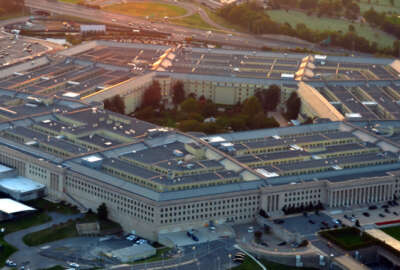
Donovan steps aside from DoD’s top personnel job as Senate considers his nomination
The Federal Vacancies Reform Act means Matthew Donovan, the acting undersecretary for personnel and readiness, must step aside from the role while the Senate...
This week’s nomination of Matthew Donovan to be the Pentagon’s undersecretary for personnel and readiness is good news for an organization that’s long had more vacancies than Senate-confirmed officials in its political leadership ranks.
But at least in the short term, it will also mean another disruption in continuity of leadership for the P&R office. Since last December, Donovan has been serving as the acting undersecretary, but the Federal Vacancies Reform Act bars him from staying there while his nomination for the permanent job is under Senate consideration.
Because of that, for the time being, Donovan has returned to the position of undersecretary of the Air Force, the job the Senate confirmed him for in 2017 and that he held until December, said Lisa Lawrence, a Pentagon spokeswoman.
In the meantime, rather than temporarily appoint someone from within the personnel and readiness office to lead the organization, DoD has tapped someone from within Defense Secretary Mark Esper’s inner circle. Dr. Alexis Ross, Esper’s deputy chief of staff, is now performing the duties of the undersecretary.
Ross is a relatively recent arrival to the Office of the Secretary of Defense. She came to Esper’s office late last year after having served as the assistant secretary of the Army for strategy and acquisition reform. She’d previously worked two different stints as a professional staff member for the House Armed Services Committee, where she specialized in acquisition and military readiness issues.
The Senate Armed Services Committee has scheduled a confirmation hearing for Donovan next week, but it’s unclear how long it will take for the full Senate to take up his nomination. If the full body gives its approval, he would be the first Senate-confirmed undersecretary for personnel and readiness since May 2018, when Robert Wilkie left DoD to lead the Department of Veterans Affairs.
Political vacancies have been a broader problem across the P&R organization for several years, however. As of now, only one of its five Senate-confirmable positions — the assistant secretary for health affairs — is filled by a confirmed official. That position had also been vacant until last August, when the Senate confirmed Thomas McCaffery.
The top job, however, has been particularly difficult to fill for nearly a decade: no single person has held the position for any longer than two years at a time since the George W. Bush administration, when David Chu led P&R throughout both of President Bush’s terms in office.
During the Obama administration, the position also saw frequent changes and vacancies. The undersecretary position in that era was filled by six different people, only three of whom had been confirmed by the Senate for that role.
The Vacancies Act provision that required Donovan to return to his previous job mirrors the situation that caused blips in DoD’s overall leadership structure last year.
At that time, then-Army secretary Mark Esper had been named as the acting Defense secretary following the sudden resignation of Patrick Shanahan, the deputy Defense secretary who had been leading the Pentagon since James Mattis’ departure several months earlier.
When President Trump nominated Esper to be the permanent secretary, he had to temporarily return to his Army job. Since the Navy secretary was next up in the Pentagon’s order of succession, then-Navy secretary Richard Spencer assumed the Defense secretary role for a few days before the Senate confirmed Esper.
Copyright © 2025 Federal News Network. All rights reserved. This website is not intended for users located within the European Economic Area.
Jared Serbu is deputy editor of Federal News Network and reports on the Defense Department’s contracting, legislative, workforce and IT issues.
Follow @jserbuWFED
Related Stories






